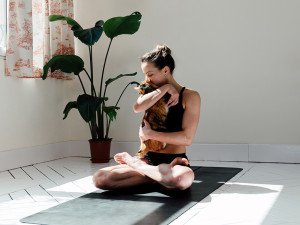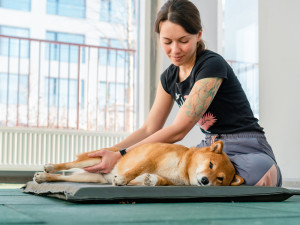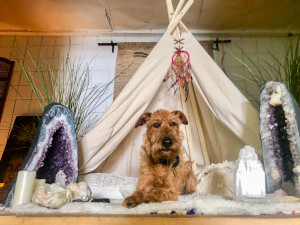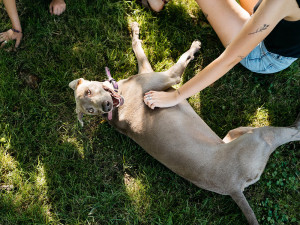Why You Should Do Breathwork With Your Dog—Really
It might sound woo-woo, but it can benefit you both.

Share Article
Here’s your unsolicited health tip for the new year: Breathwork is not only good for us, it’s also good for the animals around us. I bet you’d agree that’s awesome news if you aren’t thinking, I’m good at breath, and I’m good at work — is that breathwork?
Not exactly. At its most basic, breathwork is breathing intentionally. I describe it as active meditation, which is great for the herding-dog-type of humans out there who always need something to do, even when we’re supposed to be relaxing. (Umm, guilty as charged.) Breathwork is a mindfulness practice that can bring about a sense of grounding, boost energy, help identify and regulate emotions, release tension, and clarify thoughts. It can last for two minutes or 45 minutes — it’s not about the quantity but the quality of your breathing. You know, that thing that’s constantly happening and keeping us alive, whether we pay attention to it or not?
Before we go further on the explain-train, could you do me a favor? Sit next to your dog and close your eyes… oh wait, you can’t read with your eyes closed, forget that. Open your eyes. Still, if it feels comfortable, take a deep and slow inhale through your nose, then exhale all the air out of your mouth. Do it again. One more time? Congratulations, you just helped your dog’s life and your own.
For real. That can count as breathwork, and that can be enough to center you. I know it might sound kind of woo-woo. I’m admittedly kind of woo-woo. But here’s why: When I show up more aware and awake, when I’ve tended to my own wellbeing, I show up better for the dogs in my life, both my own and dogs I’m fostering. Technically, breathwork is a self-care tool, but it’s also something we can do for our dogs and for our relationship with them.

Breathwork is good for your dog.
Sharing presence with someone can be an act of love. Serenading dogs or setting up a candlelight dinner might not cut it, but doing breathwork together is “dropping in” to meet them in the moment where they are. Generally, pups don’t carry around a past they dwell in or a future they worry about. They don’t slip into a time that is not happening now the way we humans do. Isn’t that what we appreciate most about our pets, how present they are? Breathwork offers a portal to join them there.
It feels comforting to sense somebody there, really there in the room with you. Dogs can feel our presence, they sense when our focus includes them or not. Just ask any dog walker who whips out their phone to check text messages how that impacts the other end of the leash. “Dogs understand eye contact. They understand when we are regarding them,” says Laura Londonopens in new tab, professional dog trainer, licensed Family Pawsopens in new tab educator, and certified canine massage practitioner. “When we regard somebody, they have identity,” London adds.
London tells me dogs today are less scent-oriented than their ancestors. They no longer need to forage for food or where to sleep, so they no longer use their noses the way they were made to be used. In her opinion, this is a contributing factor to a rise in behavioral challenges. The olfactory formation in dogs is designed with far more advanced functioning than is the case in humans. “When dogs use their noses more, they breathe more, and when they breathe more, they take in more information that can help them calm down. It’s why nosework is so powerful. Breathwork is sort of like nosework for humans,” London points out.
In my experience, breathwork allows people to slow down and realize what they’re thinking in their heads and feeling in their bodies. This noticing sends a message to ourselves that we count. And once we know how to give this level of regard to ourselves, we can give it more easily to our pets, elevating the sense of inherent worth in both of us. On top of the fact that when we breathe mindfully beside our dogs we share the moment with them and give them loving attentiveness, we also acknowledge them giving the same back to us, recognizing the value they add in our lives.
Another reason breathwork is good for dogs?
When we’re balanced instead of stressed, it sets the stage for improved behavior from our dogs and increases the likelihood that any training we do with them sticks. Our serenity makes dogs more eager opens in new tab to engage with us and follow our lead. “Dogs learn through association and context, so if you change your behavior, the association a dog has with you changes, and you can get a different relationship with different results. It’s why a dog is OK with one person and their particular speed, energy, and breath, but not OK with another person,” London tells me. “Generally, dogs prefer a calmer energy. I tell my clients, it’s not about the dog. People are my real clients, and mostly I have to teach them about the art of doing nothing. Showing their dog how to chill. That’s the thing.”
Doing breathwork with your dog is a way to chill with your dog. It allows a dog to associate peace with their person, and a person to associate peace with their dog. The payoff can be huge in terms of our dogs’ overall demeanor (and our own).
Breathwork is good for you.
Let’s take a breathwork break. Inhale deeply but through the mouth this time, and exhale slowly through the mouth, too. Continue that breath pattern.
FYI, when you do this, you’re also taking in more oxygen. Duh, you probably know that, but when we breathe fully, we nourish our bodies and brains with more air. More air usually translatesopens in new tab into a less foggy mind and a greater aptitude in our muscles. When we are lost in unaware negative thinking spirals, we tend to breathe shallower and faster, causing less oxygen to get in, which means less nourishment for us, which means less clarity of the mind and less capacity for the body. Remember the age-old airplane analogy which insists we put our own oxygen mask on first? We have to be breathing to be at our best, and only then can we help anyone else.
Fellow certified trauma-informed breathwork facilitator, Brenda Winkleopens in new tab, who is also a certified trauma-informed somatic coach, energy healer and trauma-informed Reiki Master, tells me, “One of the benefits of doing breathwork with a facilitator is that you get to experience co-regulationopens in new tab.” That’s a term used to describe the process of supporting someone as they navigate emotions by offering them a nonjudgmental environment. Co-regulation ushers in connection, a witnessing container, and creates a blanket of trust. When we breathe with our dogs, they in essence co-regulate with us.
Many emotions may arise during breathwork, whether that be anger, sadness, grief, joy, or something else, because intentional breathing can help move energy. “Co-regulation produces a sense of safety in the body,” Winkle says, which may be what allows stuck emotions to process and integrate. (Translation from woo-woo speak: It feels safe to process emotions in the presence of somebody who cares and isn’t trying to fix or control you.)
Physical symptoms like lightheadedness, temperature change, and tingling are also common during breathwork because changing our breathing affects our body. There are physical benefits from doing breathworkopens in new tab, too, ranging from lowering blood pressure to improving immune functioning to promoting restful sleep.
The aha moment
When I started doing breathwork, I noticed how my own blind and deaf senior Pitbull, Wally, would clomp over from wherever he was in the house to push the door open with his head, plop on the rug, and lay beside me. Now as a breathwork facilitator myself, I wonder if it feels good for him to hold space for me while I’m doing breathwork, just as I enjoy to hold space for others. I believe that as I breathe intentionally, my Pittie can detect my levels of cortisol, the stress hormone, dropping. (Again, translation: My dog’s nose can actually pick up on my lowering cortisol levels.)
Winkle agrees. “I adopted my dog, Bentley, and was a couple of months in when I did a breathwork session. As I dropped into a slow breath, Bentley dropped in beside me. He was co-breathing and co-regulating with me,” she explains. She credits regular breathwork together with helping Bentley grow more confident, overcome anxiety, and adjust, all of which have contributed to the closeness they’ve developed.
Breathwork is good for the relationship.
Yet one more reason that I recommend doing breathwork with your dog: It is good for the relationship between you. You are working with your dog when you work on yourself. You are bonding and nurturing the love between you when you implement self-care.
We know dogs communicate through body language. But how often do we hear them? And how often do we communicate through our own bodies in response, purposefully and clearly? Dogs learn to read our signs, they tune into us, even when we don’t realize what we’re demonstrating. “If we go in hot and our head isn’t clear, our breathing isn’t deep and our heart rate goes up. Our dogs will spike and sync up to that stress,” London says. “You take a dog with a high frequency and meet them with a high emotional state, and that dog won’t know how to come down. We won’t be able to tell what’s going on. We have to be a thermostat and set the temperature for both of us.”
“If we don’t like the behavior our dog is exhibiting, we can look at how we are behaving because usually there is a tie,” Winkle corroborates. “My dog responds directly to my nervous system. If I am relaxed, he is. If I am agitated, he is. When it comes to dogs, if we don’t like how they’re behaving, it’s an opportunity to look in the mirror and ask how we’re showing up in our lives. It’s hard to do and not always comfortable, but usually the dog’s behavior is a symptom.”
Perhaps breathwork is where dog behavior and self-help can intersect. OK, I admit, that was super woo woo. But hear me out: There is an overlap between us and our dogs. Our wellbeing is interconnected with the wellbeing of the animals we take care of, because what we think determines what we feel, and what we feel determines what we do. We impact one another. Maybe we breathe with our dogs to listen to them better. Using this logic, when we breathe, we talk to them.
Respiration, inspiration, motivation, transformation
For those who struggle to meditate because it feels boring, breathwork can offer a nice alternative. For others, breathwork might be too intense. I invite you to get curious and experiment with wellness modalities. Search for certified facilitators who align with what you’re seeking, or use an app with a varied resource library, like InsightTimer.opens in new tab
Even if all you do is sit beside your dog and lay a hand on their belly (if they like that) and observe the rise and fall of their breath, and observe the same in yourself, that simple awareness of inhales and exhales could mean a lot for you, for your beloved dog, and for the dynamic you share.
References
Anastasio, Alexandra. “Keeping Calm in a Crisis: Why It’s Important for Both You and Your Dog.” American Kennel Club, May 3, 2018, www.akc.org/expert-advice/advice/keeping-calm-in-a-crisis/.
Fincham, Guy William, et al. “Effect of Breathwork on Stress and Mental Health: A Meta-Analysis of Randomised-Controlled Trials.” Scientific Reports, vol. 13, no. 1, 9 Jan. 2023, https://doi.org/10.1038/s41598-022-27247-yopens in new tab.
“How Shallow Breathing Affects the Body and Mind — Calm Blog.” Calm Blog, www.calm.com/blog/shallow-breathingopens in new tab.
Salamon, Maureen. “Co-Regulation: Helping Children and Teens Navigate Big Emotions.” Harvard Health, 3 Apr. 2024, www.health.harvard.edu/blog/co-regulation-helping-children-and-teens-navigate-big-emotions-202404033030opens in new tab.
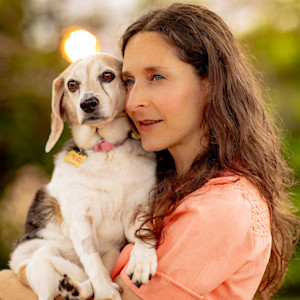
Katya Lidsky
Katya Lidsky is a writer, and a trauma-informed certified breathwork facilitator and creative grief coach who specializes in supporting animal shelters, rescue groups, and veterinary teams with wellness practices. She is more than mildly obsessed with senior dogs, rescue pets, and the people who care about them.
Related articles
![A woman walking with her dog in a garden.]()
How to Take Your Dog On a Mindful Nature Walk
Wellness experts and animal trainers agree: A tuned-in outdoor outing can be restorative for both people and pets.
![A woman holding a cat close to her while sitting on a yoga mat.]()
Shockingly, Your Pet Will Enhance Your Mindfulness Practice
The next time they try to kiss your face while you’re in corpse pose, let them.
![Woman with arm tattoos and wearing a black t-shirt stretching out the back legs of a Shiba Inu dog laying on a dark green mat]()
Does Your Dog Need a Massage?
Help your dog stay fit and flexible with these stretch techniques by a certified pet strength and conditioning specialist.
![Dog sitting in a tent surrounded by candles and crystals]()
Alternative Therapies Can Zen Out Your Pet, Too
Wellness treatments like acupuncture, Reiki, and sound baths are helping pets heal and bond with their parents.
![Girls Playing With Their Dog At The Park]()
Research Confirms CBD Is a Safe Way to Get Your Dog to Chill Out
New research finds the hemp derivative can help your dog with car and separation anxiety.
![a brown dog sleeps on a gray couch, surrounded by white pillows]()
Catnip for Dogs: Is it Safe?
In fact, it chills them out.




